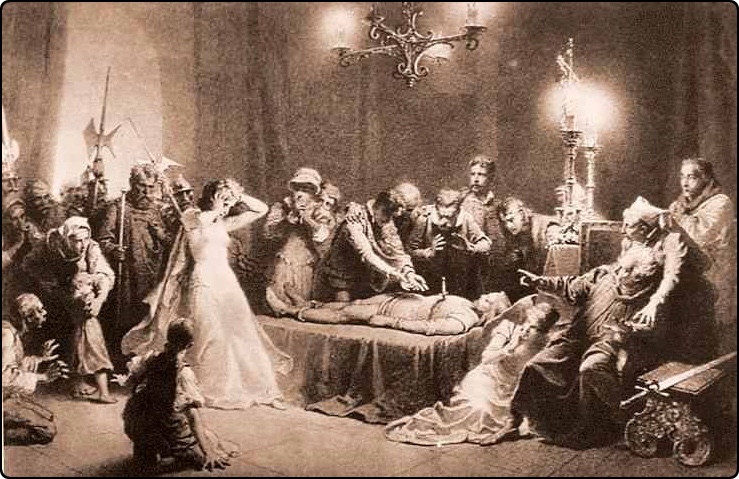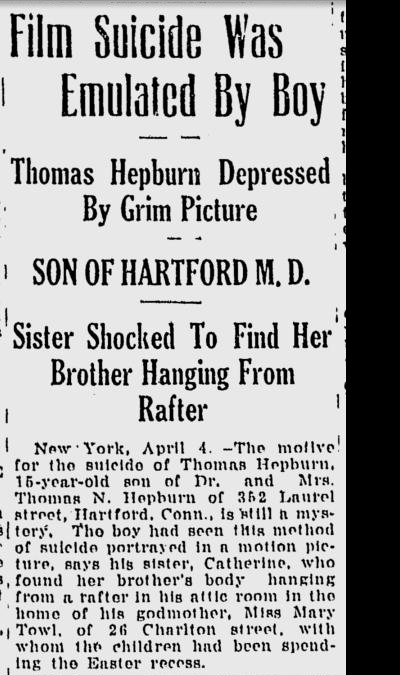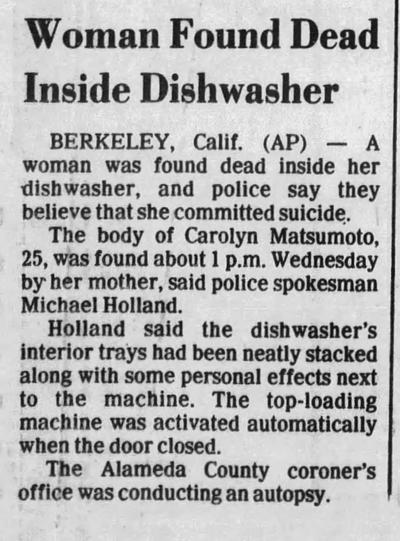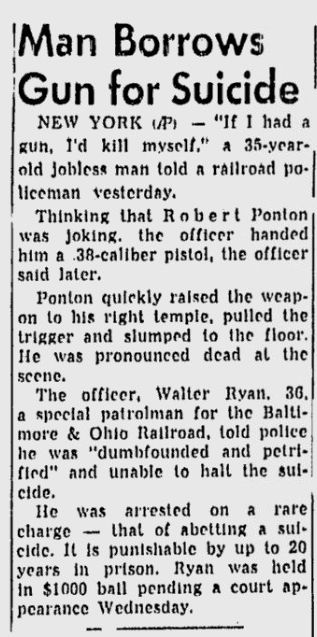Death
Death by Myopia

Click to embiggen.
Original story here.
Posted By: Paul - Sun Aug 07, 2016 -
Comments (2)
Category: Death, Law, 1980s, Eyes and Vision
Trial By Touch

Back in colonial times, the American legal system occasionally relied upon a curious form of murder investigation known as "Trial by Touch." The book Legal Executions in New England: A Comprehensive Reference offers this explanation:
That same book offers a number of examples of people found guilty by means of the Trial by Touch. For instance, in 1644 Goodwife Cornish of York, Maine, was accused of killing her husband, whose body was found floating in the York River:
Both of the accused were next brought before a council of local officials. The ensuing "trial" was a farce. The prosecution's only evidence was the result of the "Trial by Touch" and hearsay about the woman's character. It was her reputation more than anything else that counted against Goodwife Cornish. She was declared guilty and condemned to death. Edward Johnson was acquitted.
During her "trial" Goodwife Cornish continued to deny all knowledge of the murder. She repeated her admissions of lewd conduct and even named a local official as one of her lovers. Few doubted the story because the man had a reputation of his own. Goodwife Cornish was hanged at York in December of 1644. There the matter ended.
Trial by Touch was referred to by a number of different names, such as "Ordeal by Touch" or "Ordeal of the Bier." The Penny Magazine (January 1842) explains this latter name:
I haven't found much info in academic sources about the Trial by Touch. Evidently the custom was widely practiced throughout Europe during the Middle Ages and then brought to America by settlers. And apparently a bleeding corpse wasn't the only indicator of guilt. If the corpse seemed to change color, sweat, or move at all, that would be enough to convict the accused. In The Old Farmer and His Almanack (1920), GL Kittredge offers the example of the trial of Johan Norkott in England (1628):
The illustration at the top is by the Hungarian artist Mihály Zichy (1894). It depicts a scene from a ballad about a woman found guilty, by means of the Ordeal by Touch, of killing her young husband (via Hungarian Art History).
Posted By: Alex - Fri Jul 29, 2016 -
Comments (1)
Category: Crime, Customs, Death
Teen Suicide Inspired by Media!

Yes, a "contemporary" trend happening in 1921.
Original story here.
Posted By: Paul - Fri Jul 29, 2016 -
Comments (3)
Category: Death, Suicide, Movies, Teenagers, 1920s
The Case of Officer Hallibrand
"Driving while dictating." The automobile texting problem of its era.
Posted By: Paul - Tue Jul 19, 2016 -
Comments (3)
Category: Death, Motor Vehicles, Police and Other Law Enforcement, PSA’s, 1950s
Shave the Corpse
Another phrase that would be a great name for a band.According to the Charles Addams blog, this ad was originally published in January 1912 in Casket and Sunnyside ("The foremost journal of the funeral profession since 1871").

Posted By: Alex - Thu Jul 07, 2016 -
Comments (4)
Category: Death, Baths, Showers and Other Cleansing Methods, 1910s
Crocodile Cage Diving
Yes or no?
Info here.
Posted By: Paul - Sun Jul 03, 2016 -
Comments (2)
Category: Animals, Daredevils, Stuntpeople and Thrillseekers, Death, Australia
Death by Dishwasher
This is disturbing, but also definitely weird. Of all the possible ways to off yourself, why choose a dishwasher? Evidently some psychiatric issues were involved.
St. Louis Post-Dispatch - May 18, 1984
BERKELEY, Calif. (AP) — A woman was found dead inside her dishwasher, and police say they believe that she committed suicide.
The body of Carolyn Matsumoto, 25, was found about 1 p.m. Wednesday by her mother, said police spokesman Michael Holland.
Holland said the dishwasher's interior trays had been neatly stacked along with some personal effects next to the machine. The top-loading machine was activated automatically when the door closed.
The Alameda County coroner's office was conducting an autopsy.
Posted By: Alex - Wed Jun 29, 2016 -
Comments (6)
Category: Death, Suicide, 1980s
Borrowed Gun
January 1958: "If I had a gun, I'd kill myself," unemployed Robert Ponton told police officer Walter Ryan. So Ryan handed him his gun, and Ponton shot himself. Ryan, who was later charged with abetting a suicide, said he was "dumbfounded and petrified" by what Ponton had done.
Southeast Missourian - Jan 28, 1957
Posted By: Alex - Thu Jun 16, 2016 -
Comments (3)
Category: Death, Suicide, 1950s
Bullet-proof Bible

Original ad here.
Posted By: Paul - Wed Jun 08, 2016 -
Comments (11)
Category: Death, Religion, Superstition, 1950s, Weapons
Follies of the Madmen #283
"But, Betty, I can't fit the corpse into the upright model so easily!"
Posted By: Paul - Thu May 26, 2016 -
Comments (13)
Category: Business, Advertising, Products, Death, Appliances, 1950s

| Who We Are |
|---|
| Alex Boese Alex is the creator and curator of the Museum of Hoaxes. He's also the author of various weird, non-fiction, science-themed books such as Elephants on Acid and Psychedelic Apes. Paul Di Filippo Paul has been paid to put weird ideas into fictional form for over thirty years, in his career as a noted science fiction writer. He has recently begun blogging on many curious topics with three fellow writers at The Inferior 4+1. Contact Us |




